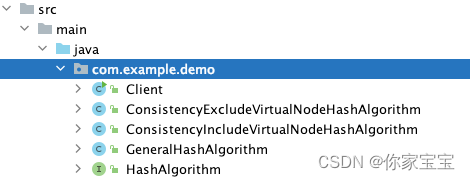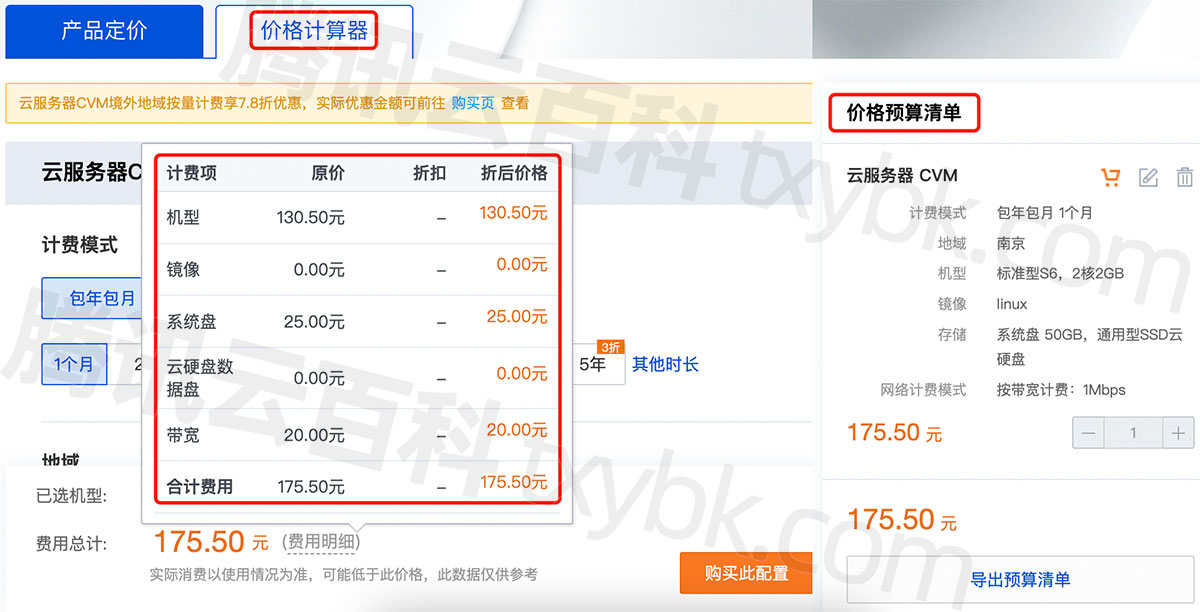文章目录
- 【 1. 函数重载 】
- 【 2. 运算符重载 】
- 2.1 可重载运算符 / 不可重载运算符
- 2.2 一元 运算符重载
- 2.3 二元 运算符重载
- 2.4 关系 运算符重载
- 2.5 输入/输出 运算符重载
- 2.6 ++和-- 运算符重载
- 2.7 赋值 运算符重载
- 2.8 函数调用() 运算符重载
- 2.9 下标[ ] 运算符重载
- 2.10 类成员访问-> 运算符重载
- C++ 允许在同一作用域中的某个函数和运算符指定多个定义,分别称为 函数重载 和 运算符重载。
- 重载声明是指一个与之前已经在该作用域内声明过的函数或方法具有 相同名称的声明,但是它们的 参数列表和定义(实现)不相同 。
- 当我们调用一个重载函数或重载运算符时,编译器通过把使用的参数类型与定义中的参数类型进行比较,决定选用最合适的定义。这个选择最合适的重载函数或重载运算符的过程,称为 重载决策 。
【 1. 函数重载 】
- 在同一个作用域内,可以声明几个功能类似的同名函数,但是这些 同名函数的形式参数(指参数的个数、类型或者顺序)至少有1个必须不同。我们不能仅通过返回类型的不同来重载函数。
- 实例
// 调用相同函数名但形参不同的类的成员函数,实现不同的输出功能。
#include <iostream>
using namespace std;
class printData
{
public:
void print(int i)
{
cout << "整数为: " << i << endl;
}
void print(double f)
{
cout << "浮点数为: " << f << endl;
}
void print(char c[])
{
cout << "字符串为: " << c << endl;
}
};
int main(void)
{
printData pd;
pd.print(5); // 输出整数
pd.print(500.263);// 输出浮点数
char c[] = "Hello C++";
pd.print(c);// 输出字符串
return 0;
}
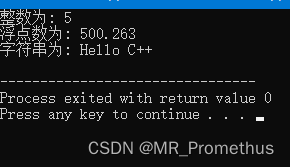
【 2. 运算符重载 】
- 通过重定义或重载大部分 C++ 内置的运算符。我们就能使用 自定义类型的运算符。
- 重载的运算符是带有特殊名称的函数,函数名是由关键字 operator 和其后要重载的运算符符号构成的。与其他函数一样,重载运算符有一个返回类型和一个参数列表。如下所示:
Box operator+(const Box&);
- 声明加法运算符用于把两个 Box 对象相加,返回最终的 Box 对象。大多数的重载运算符可被定义为普通的非成员函数或者被定义为类的成员函数。如果我们定义上面的函数为类的非成员函数,那么我们需要为每次操作传递两个参数,如下所示:
Box operator+(const Box&, const Box&);
- 实例
//下面的实例使用成员函数演示了运算符重载的概念。在这里,对象作为参数进行传递,对象的属性使用 this 运算符进行访问,如下所示:
#include <iostream>
using namespace std;
class Box
{
public:
double getVolume(void)
{
return length * breadth * height;
}
void setLength( double len )
{
length = len;
}
void setBreadth( double bre )
{
breadth = bre;
}
void setHeight( double hei )
{
height = hei;
}
// 重载 + 运算符,用于把两个 Box 对象相加
Box operator+(const Box& b)
{
Box box;
box.length = this->length + b.length;
box.breadth = this->breadth + b.breadth;
box.height = this->height + b.height;
return box;
}
private:
double length; // 长度
double breadth; // 宽度
double height; // 高度
};
// 程序的主函数
int main( )
{
Box Box1; // 声明 Box1,类型为 Box
Box Box2; // 声明 Box2,类型为 Box
Box Box3; // 声明 Box3,类型为 Box
double volume = 0.0; // 把体积存储在该变量中
// Box1 详述
Box1.setLength(6.0);
Box1.setBreadth(7.0);
Box1.setHeight(5.0);
// Box2 详述
Box2.setLength(12.0);
Box2.setBreadth(13.0);
Box2.setHeight(10.0);
// Box1 的体积
volume = Box1.getVolume();
cout << "Volume of Box1 : " << volume <<endl;
// Box2 的体积
volume = Box2.getVolume();
cout << "Volume of Box2 : " << volume <<endl;
// 把两个对象相加,得到 Box3
Box3 = Box1 + Box2;
// Box3 的体积
volume = Box3.getVolume();
cout << "Volume of Box3 : " << volume <<endl;
return 0;
}
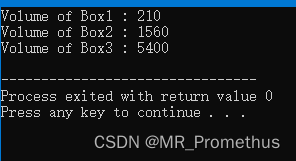
2.1 可重载运算符 / 不可重载运算符
- 可重载的运算符列表
| 类型 | 名称 |
|---|---|
| 双目算术运算符 | + 加 - 减 * 乘 / 除 % 取模 |
| 关系运算符 | == 等于 != 不等于 < 小于 > 大于 <= 小于等于 >= 大于等于 |
| 逻辑运算符 | || 逻辑或 && 逻辑与 ! 逻辑非 |
| 单目运算符 | + 正 - 负 * 指针 & 取地址 |
| 自增自减运算符 | ++ 自增 - - 自减 |
| 位运算符 | || 按位或 & 按位与 ~ 按位取反 ^ 按位异或 << 左移 >> 右移 |
| 赋值运算符 | = += -= *= /= % = &= |= ^= <<= >>= |
| 空间申请与释放 | new delete new[ ] delete[ ] |
| 其他运算符 | () 函数调用 -> 成员访问 , 逗号 [ ] 下标 |
- 不可重载的运算符列表
| 名称 | 符号 |
|---|---|
| 成员访问运算符 | . |
| 成员指针访问运算符 | . -> |
| 域运算符 | :: |
| 长度运算符 | sizeof |
| 条件运算符 | ?: |
| 预处理符号 | # |
2.2 一元 运算符重载
#include <iostream>
using namespace std;
class Distance
{
private:
int feet; // 0 到无穷
int inches; // 0 到 12
public:
// 构造函数
Distance()
{
feet = 0;
inches = 0;
}
Distance(int f, int i)
{
feet = f;
inches = i;
}
// 显示距离的方法
void displayDistance()
{
cout << "F: " << feet << " I:" << inches <<endl;
}
// 重载负运算符( - )
Distance operator- ()
{
feet = -feet;
inches = -inches;
return Distance(feet, inches);
}
};
int main()
{
Distance D1(11, 10), D2(-5, 11);
-D1; // 取相反数
D1.displayDistance(); // 距离 D1
-D2; // 取相反数
D2.displayDistance(); // 距离 D2
return 0;
}
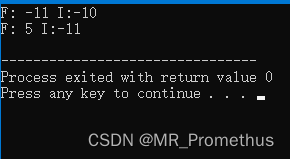
2.3 二元 运算符重载
#include <iostream>
using namespace std;
class Box
{
double length; // 长度
double breadth; // 宽度
double height; // 高度
public:
double getVolume(void)
{
return length * breadth * height;
}
void setLength( double len )
{
length = len;
}
void setBreadth( double bre )
{
breadth = bre;
}
void setHeight( double hei )
{
height = hei;
}
// 重载 + 运算符,用于把两个 Box 对象相加
Box operator+(const Box& b)
{
Box box;
box.length = this->length + b.length;
box.breadth = this->breadth + b.breadth;
box.height = this->height + b.height;
return box;
}
};
// 程序的主函数
int main( )
{
Box Box1; // 声明 Box1,类型为 Box
Box Box2; // 声明 Box2,类型为 Box
Box Box3; // 声明 Box3,类型为 Box
double volume = 0.0; // 把体积存储在该变量中
// Box1 详述
Box1.setLength(6.0);
Box1.setBreadth(7.0);
Box1.setHeight(5.0);
// Box2 详述
Box2.setLength(12.0);
Box2.setBreadth(13.0);
Box2.setHeight(10.0);
// Box1 的体积
volume = Box1.getVolume();
cout << "Volume of Box1 : " << volume <<endl;
// Box2 的体积
volume = Box2.getVolume();
cout << "Volume of Box2 : " << volume <<endl;
// 把两个对象相加,得到 Box3
Box3 = Box1 + Box2;
// Box3 的体积
volume = Box3.getVolume();
cout << "Volume of Box3 : " << volume <<endl;
return 0;
}
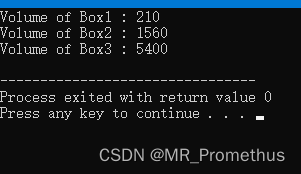
2.4 关系 运算符重载
#include <iostream>
using namespace std;
class Distance
{
private:
int feet; // 0 到无穷
int inches; // 0 到 12
public:
// 所需的构造函数
Distance(){
feet = 0;
inches = 0;
}
Distance(int f, int i){
feet = f;
inches = i;
}
// 显示距离的方法
void displayDistance()
{
cout << "F: " << feet << " I:" << inches <<endl;
}
// 重载负运算符( - )
Distance operator- ()
{
feet = -feet;
inches = -inches;
return Distance(feet, inches);
}
// 重载小于运算符( < )
bool operator <(const Distance& d)
{
if(feet < d.feet)
{
return true;
}
if(feet == d.feet && inches < d.inches)
{
return true;
}
return false;
}
};
int main()
{
Distance D1(11, 10), D2(5, 11);
if( D1 < D2 )
{
cout << "D1 is less than D2 " << endl;
}
else
{
cout << "D2 is less than D1 " << endl;
}
return 0;
}
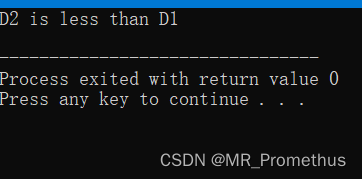
2.5 输入/输出 运算符重载
#include <iostream>
using namespace std;
class Distance
{
private:
int feet; // 0 到无穷
int inches; // 0 到 12
public:
// 所需的构造函数
Distance(){
feet = 0;
inches = 0;
}
Distance(int f, int i){
feet = f;
inches = i;
}
friend ostream &operator<<( ostream &output,
const Distance &D )
{
output << "F : " << D.feet << " I : " << D.inches;
return output;
}
friend istream &operator>>( istream &input, Distance &D )
{
input >> D.feet >> D.inches;
return input;
}
};
int main()
{
Distance D1(11, 10), D2(5, 11), D3;
cout << "Enter the value of object : " << endl;
cin >> D3;
cout << "First Distance : " << D1 << endl;
cout << "Second Distance :" << D2 << endl;
cout << "Third Distance :" << D3 << endl;
return 0;
}
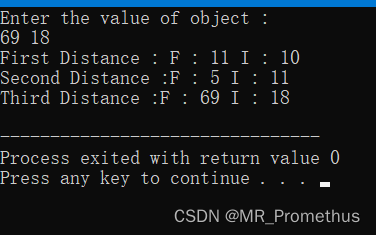
2.6 ++和-- 运算符重载
#include <iostream>
using namespace std;
class Time
{
private:
int hours; // 0 到 23
int minutes; // 0 到 59
public:
// 所需的构造函数
Time(){
hours = 0;
minutes = 0;
}
Time(int h, int m){
hours = h;
minutes = m;
}
// 显示时间的方法
void displayTime()
{
cout << "H: " << hours << " M:" << minutes <<endl;
}
// 重载前缀递增运算符( ++ )
Time operator++ ()
{
++minutes; // 对象加 1
if(minutes >= 60)
{
++hours;
minutes -= 60;
}
return Time(hours, minutes);
}
// 重载后缀递增运算符( ++ )
Time operator++( int )
{
// 保存原始值
Time T(hours, minutes);
// 对象加 1
++minutes;
if(minutes >= 60)
{
++hours;
minutes -= 60;
}
// 返回旧的原始值
return T;
}
};
int main()
{
Time T1(11, 59), T2(10,40);
++T1; // T1 加 1
T1.displayTime(); // 显示 T1
++T1; // T1 再加 1
T1.displayTime(); // 显示 T1
T2++; // T2 加 1
T2.displayTime(); // 显示 T2
T2++; // T2 再加 1
T2.displayTime(); // 显示 T2
return 0;
}
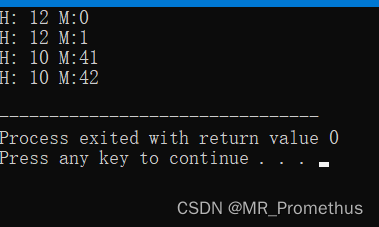
2.7 赋值 运算符重载
#include <iostream>
using namespace std;
class Distance
{
private:
int feet; // 0 到无穷
int inches; // 0 到 12
public:
// 所需的构造函数
Distance(){
feet = 0;
inches = 0;
}
Distance(int f, int i){
feet = f;
inches = i;
}
void operator=(const Distance &D )
{
feet = D.feet;
inches = D.inches;
}
// 显示距离的方法
void displayDistance()
{
cout << "F: " << feet << " I:" << inches << endl;
}
};
int main()
{
Distance D1(11, 10), D2(5, 11);
cout << "First Distance : ";
D1.displayDistance();
cout << "Second Distance :";
D2.displayDistance();
// 使用赋值运算符
D1 = D2;
cout << "First Distance :";
D1.displayDistance();
return 0;
}
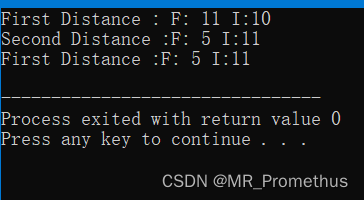
2.8 函数调用() 运算符重载
#include <iostream>
using namespace std;
class Distance
{
private:
int feet; // 0 到无穷
int inches; // 0 到 12
public:
// 所需的构造函数
Distance(){
feet = 0;
inches = 0;
}
Distance(int f, int i){
feet = f;
inches = i;
}
// 重载函数调用运算符
Distance operator()(int a, int b, int c)
{
Distance D;
// 进行随机计算
D.feet = a + c + 10;
D.inches = b + c + 100 ;
return D;
}
// 显示距离的方法
void displayDistance()
{
cout << "F: " << feet << " I:" << inches << endl;
}
};
int main()
{
Distance D1(11, 10), D2;
cout << "First Distance : ";
D1.displayDistance();
D2 = D1(10, 10, 10); // invoke operator()
cout << "Second Distance :";
D2.displayDistance();
return 0;
}
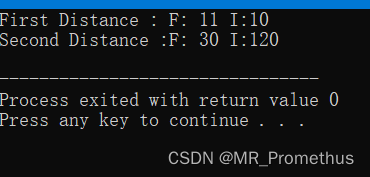
2.9 下标[ ] 运算符重载
#include <iostream>
using namespace std;
const int SIZE = 10;
class safearay
{
private:
int arr[SIZE];
public:
safearay()
{
register int i;
for(i = 0; i < SIZE; i++)
{
arr[i] = i;
}
}
int& operator[](int i)
{
if( i > SIZE )
{
cout << "索引超过最大值" <<endl;
// 返回第一个元素
return arr[0];
}
return arr[i];
}
};
int main()
{
safearay A;
cout << "A[2] 的值为 : " << A[2] <<endl;
cout << "A[5] 的值为 : " << A[5]<<endl;
cout << "A[12] 的值为 : " << A[12]<<endl;
return 0;
}
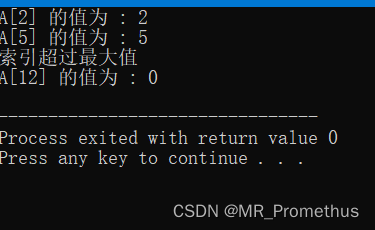
2.10 类成员访问-> 运算符重载
- 类成员访问运算符( -> )可以被重载,但它较为麻烦。它被定义用于为一个类赋予"指针"行为。 运算符 -> 必须是一个成员函数。如果使用了 -> 运算符, 返回类型必须是指针或者是类的对象。
- 运算符 -> 通常与指针引用运算符 * 结合使用,用于实现"智能指针"的功能。这些指针是行为与正常指针相似的对象,唯一不同的是,当我们通过指针访问对象时,它们会执行其他的任务。比如,当指针销毁时,或者当指针指向另一个对象时,会自动删除对象。
- 间接引用运算符 -> 可被定义为一个一元后缀运算符。也就是说,给出一个类:
class Ptr{
//...
X * operator->();
};
类 Ptr 的对象可用于访问类 X 的成员,使用方式与指针的用法十分相似。例如:
void f(Ptr p )
{
p->m = 10 ; // (p.operator->())->m = 10
}
语句 p->m 被解释为 (p.operator->())->m。
- 实例:
// 演示如何重载类成员访问运算符 ->
#include <iostream>
#include <vector>
using namespace std;
// 假设一个实际的类
class Obj {
static int i, j;
public:
void f() const { cout << i++ << endl; }
void g() const { cout << j++ << endl; }
};
// 静态成员定义
int Obj::i = 10;
int Obj::j = 12;
// 为上面的类实现一个容器
class ObjContainer {
vector<Obj*> a;
public:
void add(Obj* obj)
{
a.push_back(obj); // 调用向量的标准方法
}
friend class SmartPointer;
};
// 实现智能指针,用于访问类 Obj 的成员
class SmartPointer {
ObjContainer oc;
int index;
public:
SmartPointer(ObjContainer& objc)
{
oc = objc;
index = 0;
}
// 返回值表示列表结束
bool operator++() // 前缀版本
{
if(index >= oc.a.size() - 1) return false;
if(oc.a[++index] == 0) return false;
return true;
}
bool operator++(int) // 后缀版本
{
return operator++();
}
// 重载运算符 ->
Obj* operator->() const
{
if(!oc.a[index])
{
cout << "Zero value";
return (Obj*)0;
}
return oc.a[index];
}
};
int main() {
const int sz = 10;
Obj o[sz];
ObjContainer oc;
for(int i = 0; i < sz; i++)
{
oc.add(&o[i]);
}
SmartPointer sp(oc); // 创建一个迭代器
do {
sp->f(); // 智能指针调用
sp->g();
} while(sp++);
return 0;
}
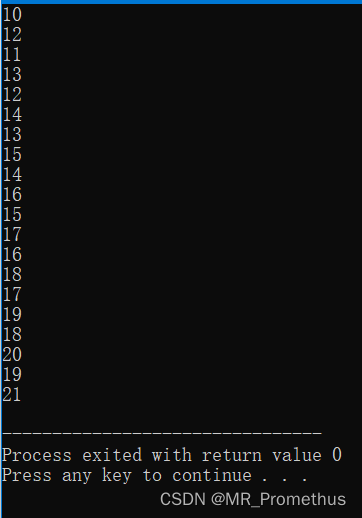

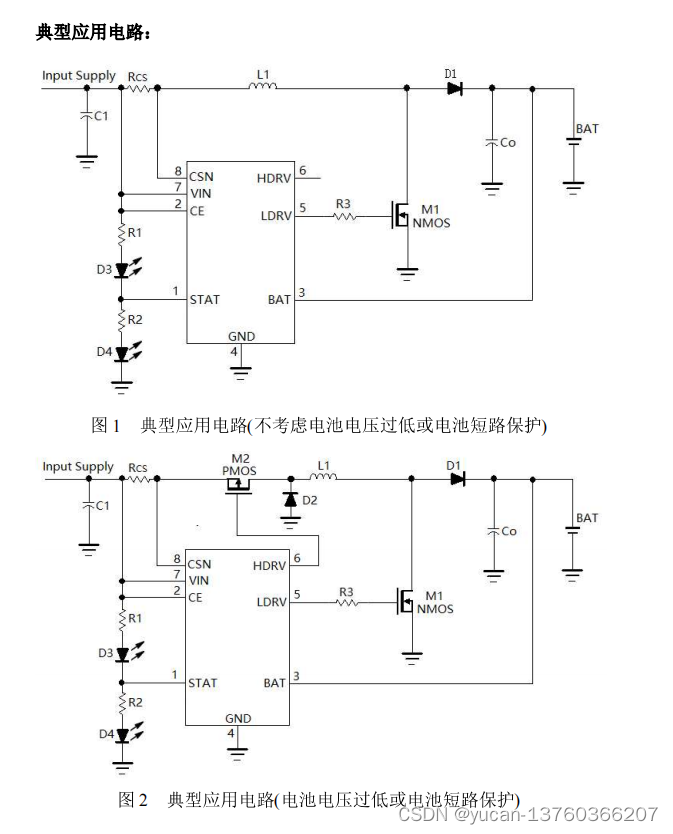



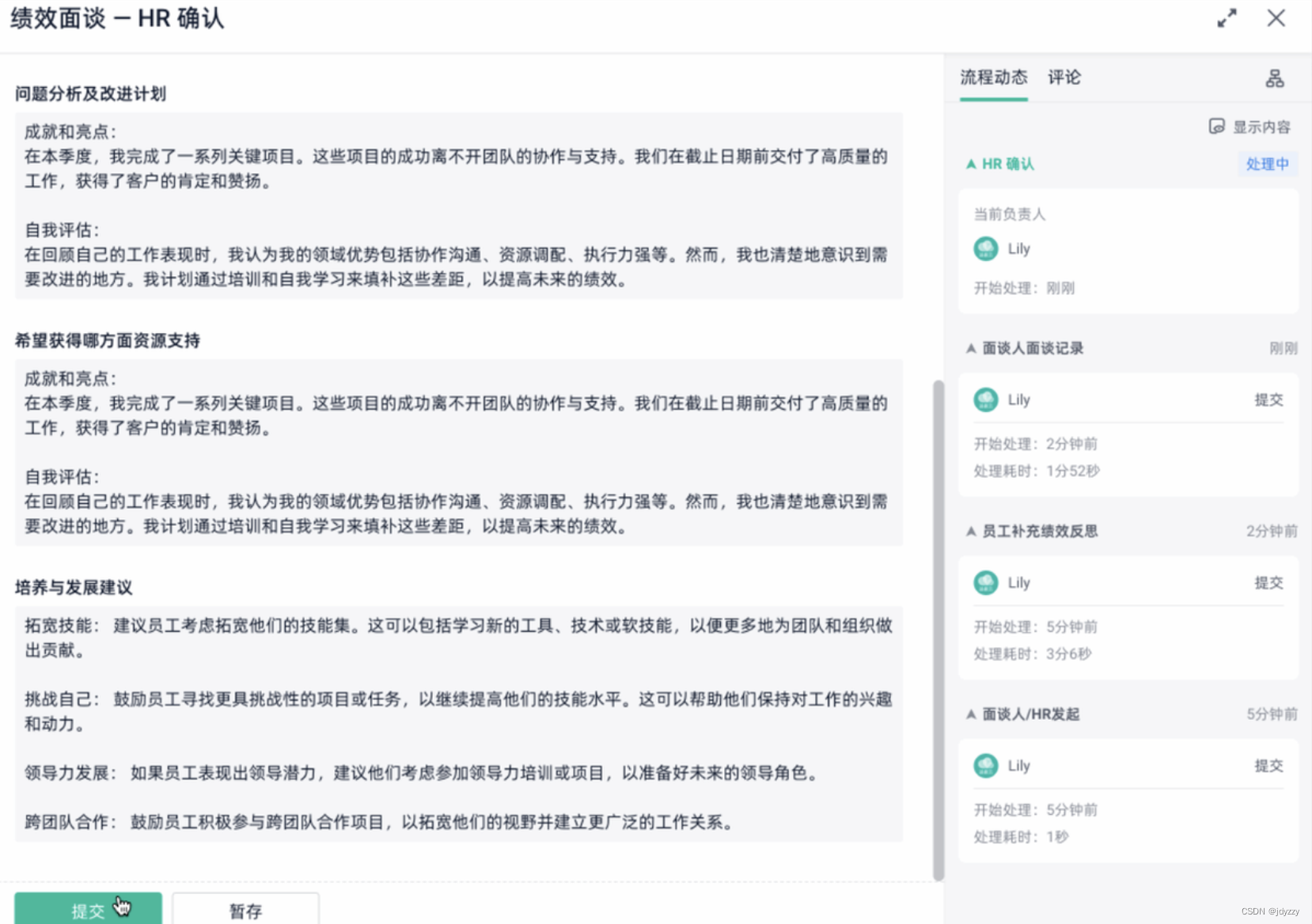
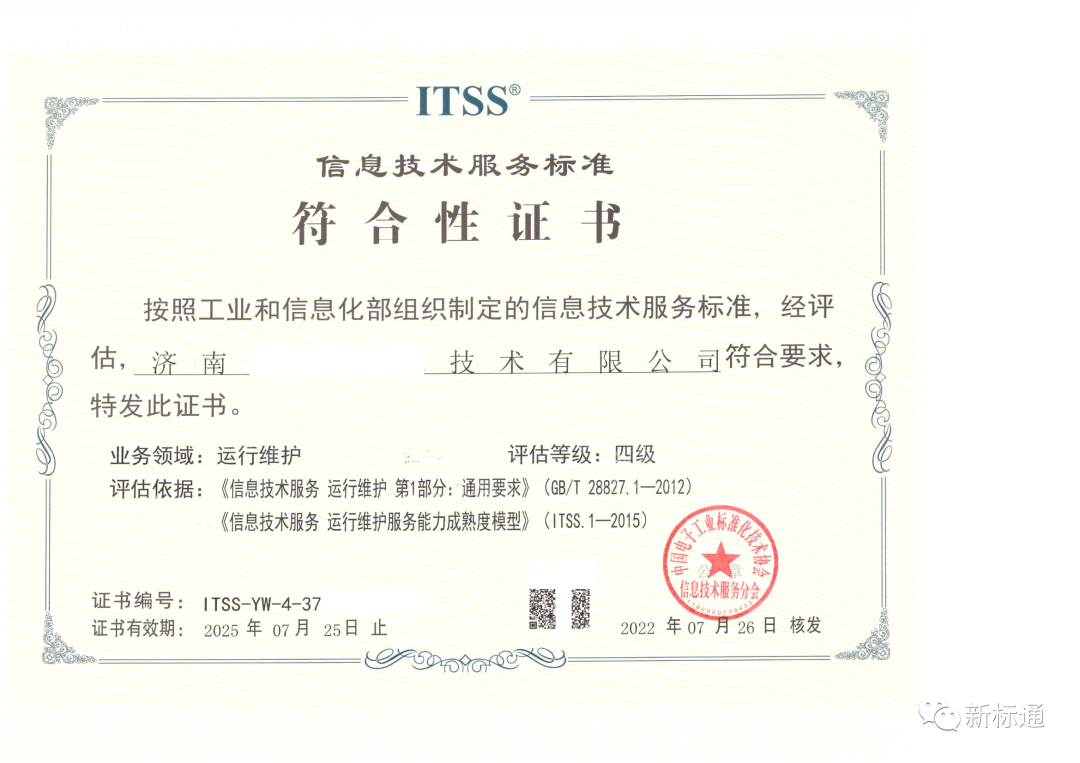
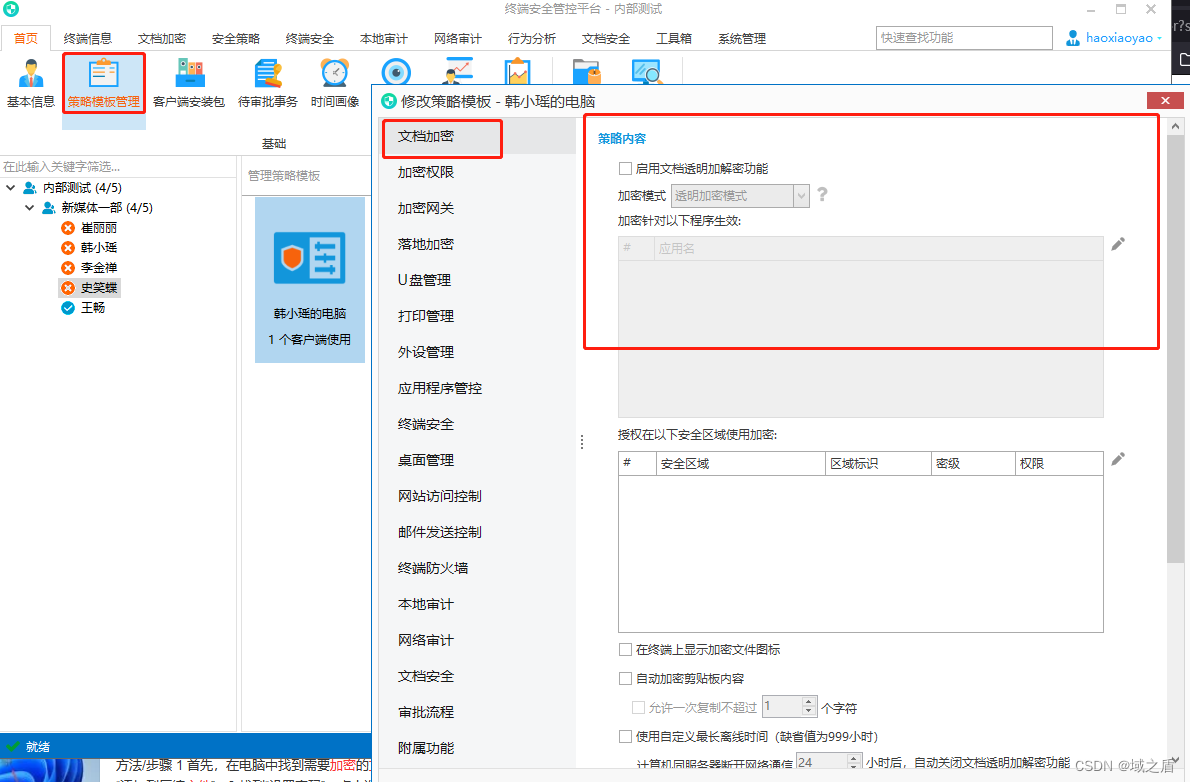
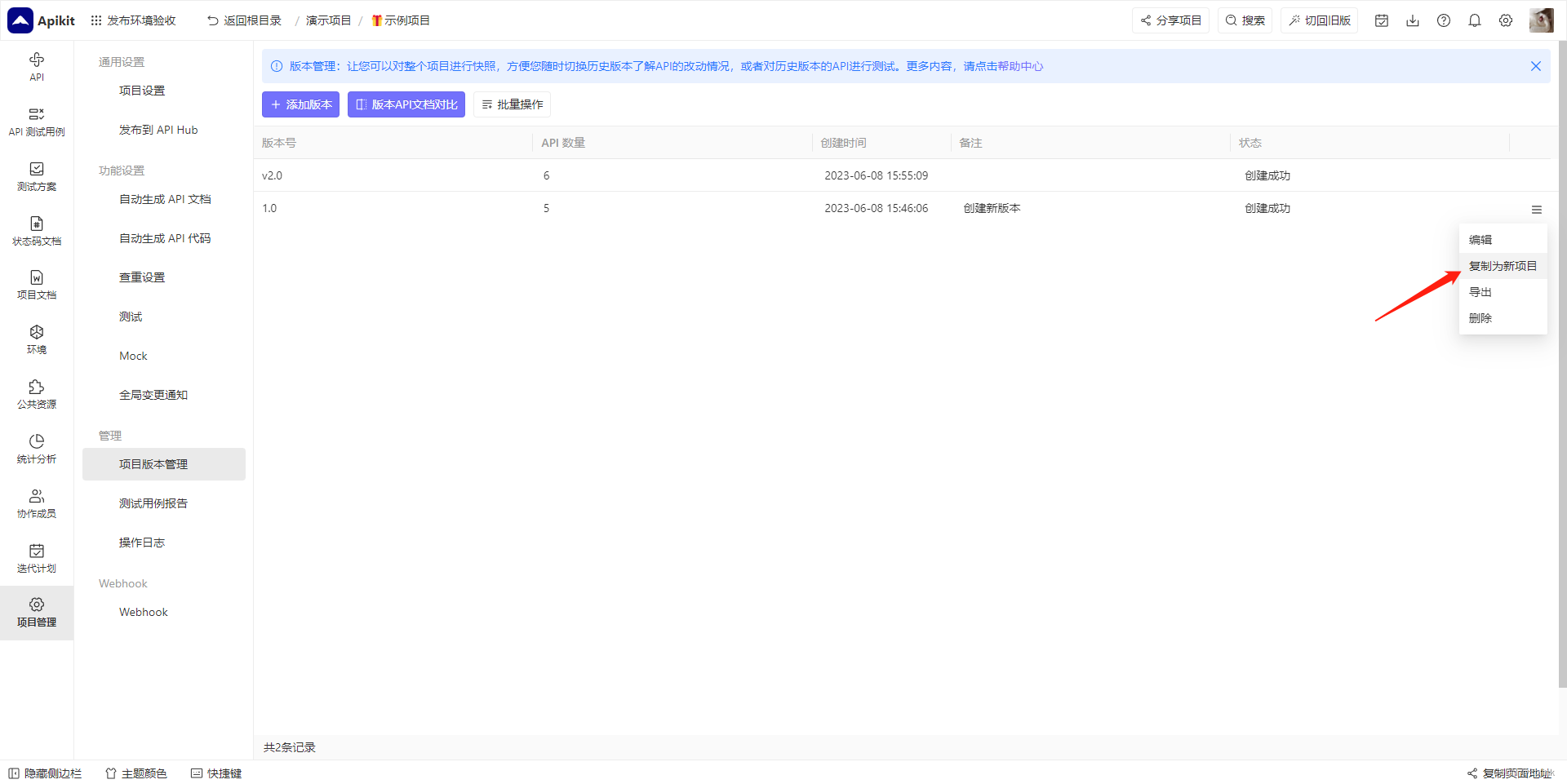
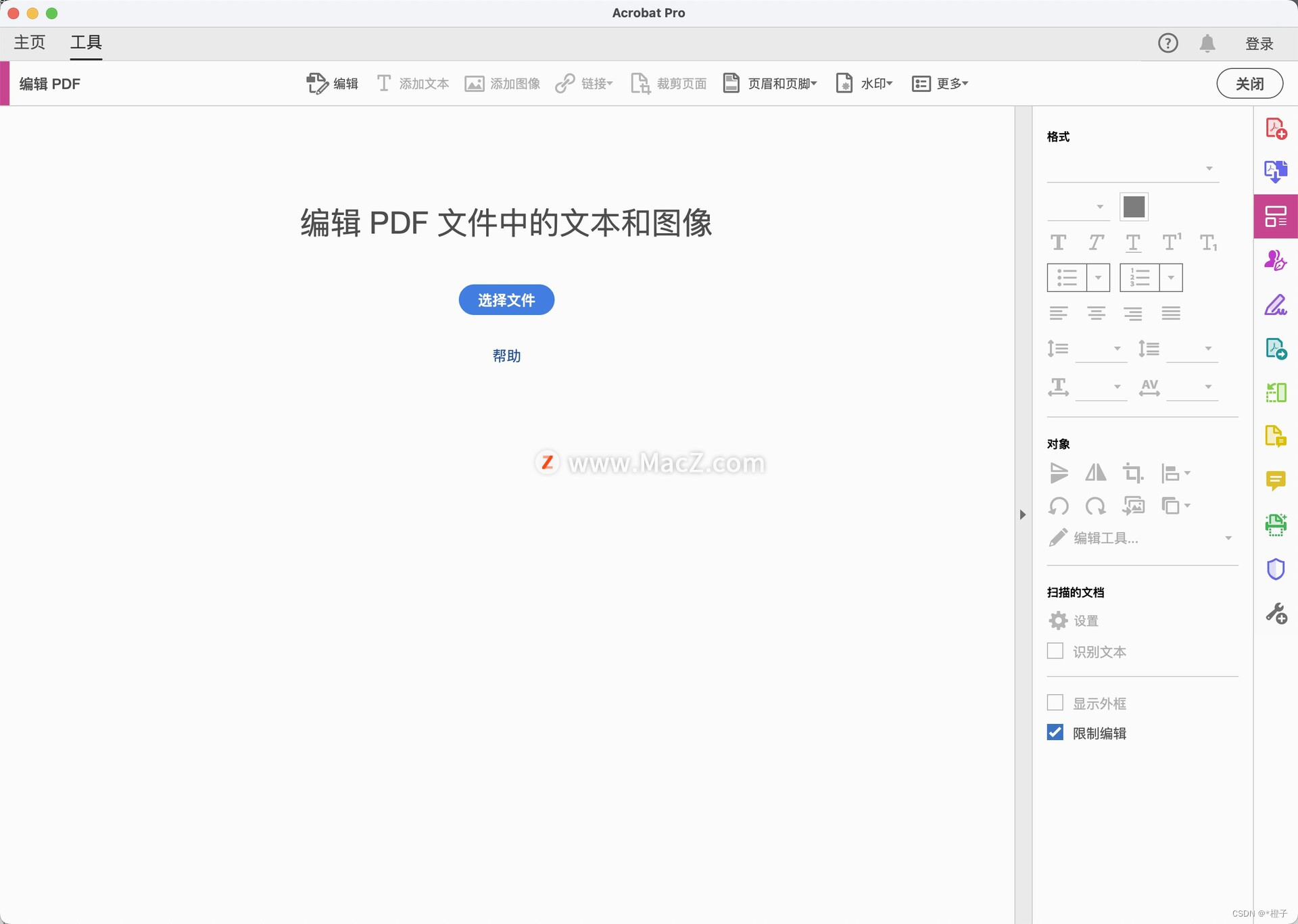
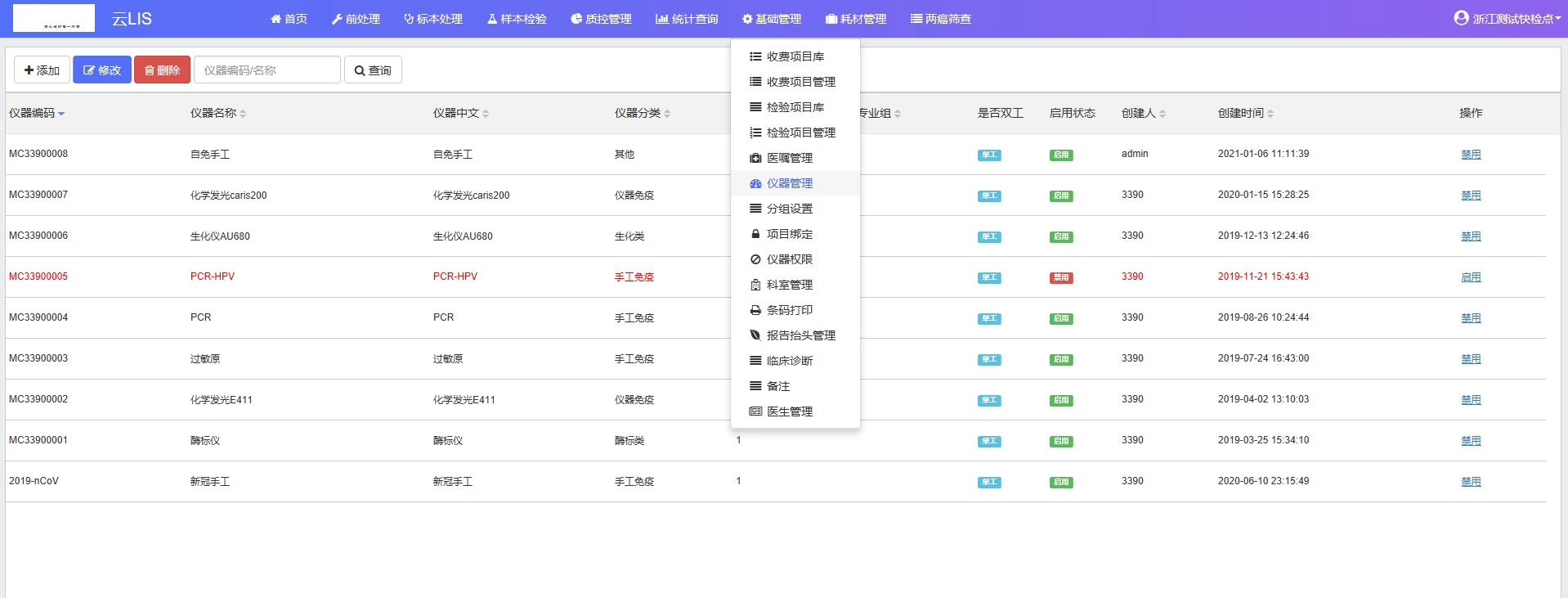

![buuctf_练[MRCTF2020]Ezaudit](https://img-blog.csdnimg.cn/img_convert/9ba99568549a4cb39141cf14ebb88177.png)

